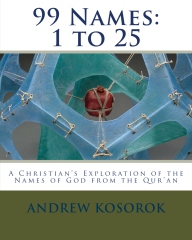The last knot was tied on Watchful (Ar-Raqib). A lot of string was used on the last couple pieces because I had to make big loops to give room for my hands, then slowly “cinch” the string until the last pieces were seated correctly. And I jabbed the back of my hands on the points a few times – whine, whine.
This is the greater stellated dodecahedron. The sculptures for the Names of this second set, 26-50, have been emerging as reflections of pollen and stars, and this seems fitting. Pollen spores help propagate life and stars guide and provide light, both nourishing growth. This Name refers to the concept that the Creator is constantly viewing His creations, steadily vigilant, and supremely aware. When I first remember hearing this in Sunday School I was in Kindergarten, and was so horrified that God was busy watching me all the time I refused to take a bath for a week, and even threw fits about changing my clothes! My parents finally were able to pry from me why I was so mortified, and were able to explain that God is keeping His “eye” on me because He loves me, and this eternal awareness is not “spying”.
Viewing is normally felt to be a passive vocation, but the implication for this Name is that God’s sight is somehow an active awareness of all we do and are, not seeing individual actions out of context but seeing all we are as a complete creature. This sight is expansive and penetrating.
On the human side, this Name reminds me of astrolabes and sailing. Muslims are taught to metaphorically keep their hearts towards Mecca and Christians are taught to keep their faces towards the place of worship – not so each of us sidle around oddly as we try to do our daily activities, but to keep a place in our heart for our awareness of God’s place in our lives. Keeping watch, so to speak, over the direction of our thoughts and all we do.

Moroccan Astrolabe
From Wikimedia Commons
Ancient sailors and travelers used the stars to navigate their way across the world, and for early pioneers in North America the Big Dipper and Polaris were particularly important. For some American religions this constellation became a beloved symbol for Christ and His teachings (one of my favorite songs, “Follow the Drinkin’ Gourd”, is a reference to this same constellation in respect to the Underground Railroad).

Big Dipper and Polaris on the LDS Christian Salt Lake Temple
Image from Simerg.com
Sailors and travelers kept constant watch of the stars to steady their direction and navigate through life. The metaphor applies to our lives as an overarching, steady and subtle awareness that success in life comes through watchfulness, responsibility, of our own actions and how they coincide/support Divine Will for our own well-being. We are, all of us, created to be magnificent creatures; our watchfulness of our own actions can help us as we listen to the “still small voice”, ever present in the background but so very quiet, which guides and directs us to fulfill our intended purpose.


































